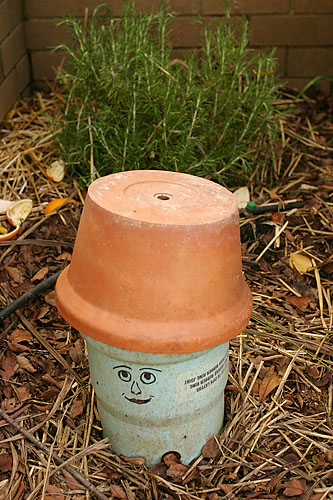
Headline!
Recently, the Canberra Chronicle featured the Millers for their part in the Environment Centre’s Sustainability Challenge. The text of the article follows;
THE Millers are just one of the many
Canberra families choosing to reduce
their impact on the environment by
taking part in a month long challenge.
More than 100 Canberra households
have signed up to take part in the
Canberra Sustainability Challenge in
an effort to reduce their carbon
emissions by changing their habits.
The Canberra Environment and
Sustainability Resource Centre
(CESRC), in association with the ACT
Government, has provided these families
with an easy kit to help them
throughout this challenge.
The challenge encourages families
to calculate their carbon footprint, pick
from a list of ideas to reduce it, and
record how easy or difficult it is to
keep up the challenge over 30 days.
Brian Miller said his family had
always been interested in environmental
issues, but was encouraged to
take up the challenge by CESRC
representatives.
‘‘We went to a fete at Evatt Primary
School and I saw the little stand they
had there and went and spoke to
them,’’ Mr Miller said.
‘‘I guess we’re sort of involved in
that sort of stuff a lot anyway.
‘‘Basically there’s a list of things
they thought we might do to reduce our
impact on the environment.’’
The list is divided into categories,
including food, mileage, energy, waste
and transport, and the families are
encouraged to choose five things and
chart their progress.
‘‘You could look through and see
we doing these things already, or
maybe we can’t do them for some
reason, and are they the sort of things
we might do for this 30 day challenge,’’
Mr Miller said.
‘‘So we picked a number of things,
then put them on a chart.
‘‘The idea was to do something
more. Not to say ‘oh we’re doing that
already’, but to do something more.
‘‘We decided to try to do one meat
meal a day, to put a minimum amount
of water in the kettle … to not use the
second TV, to try and not bring plastic
bags home, and to walk to school.’’
Mr Miller said because his family
was already quite environmentally
conscious, some of the challenges
weren’t too hard to incorporate into
their lives.
‘‘We’re quite interested in all this
stuff,’’ he said.
‘‘We’ve got chickens and veggie
gardens and compost piles.
‘‘Unfortunately my wife tripped
down the stairs and hurt her ankle.’’
This made it hard for her to walk the
children Grace, 11, and Ethan, 7, to
school.
‘‘Some of them we couldn’t do
every day,’’ Mr Miller said.
‘‘Things like the meat meal weren’t
as easy as we thought.
However, he said he would happily
continue to use minimal water in the
kettle.
‘‘It’s just another one of those
awareness things,’’ he said.
CESRC are encouraging more Canberra
families to get on board with the
30 day challenge. CESRC will also be
holding a number of events over the
coming weeks, including sustainability
workshops and tours of award winning
sustainable Canberra homes.
If you would like to participate in
the Canberra Sustainability Challenge,
visit http://www.ecoaction.com.au.

The Millers
Our list of possible activities for the challenge follows;
Food Miles
Grow our own vegetables
Buy organic food products
Be vegetarian (Sheryl fully, others part-time by default)
Reduce meat intake by going to one meat meal per day
Plan menus to reduce food waste
Keep chooks
Buy less processed food and more local
Energy
Use dish and clothes washers only for full loads
Use energy saving cycles on these machines
Cook with the lid on
Cook in single pot where possible
Fill Kettle only with as much water as you need
Dry clothes on clothes line
Use sun for heating and lighting during day
Turn the heater off at night
Don’t use the second TV
Replace incandescent lights with compact fluros
Wash clothes in cold water
Use hot water bottle instead of electric blanket
Waste
Do not use insinkerator – use worm farm and compost
Recycle egg shells on to garden as snail deterant
Freeze unused fruit for later use
Collect scraps from supermarkets and playgroup for chickens
Empty half full water bottles onto garden
Resue washing up water on plants with scale or aphids
cut grass longer – compost clippings
Use re-usable shopping bags – try 30 days plastic bag free
Recycle and reuse as much as possible (very little rubbish to landfill)
Re-use plastic packaging rather than garbage bags
Buy second hand goods
Transport
Walk to work or school twice a week
Take fewer car trips
Use ethanol fuel
And below, some of the systems which we are working on to build a sustainable lifestyle;
Run business from home office to reduce travel and premises energy use
Grid connect solar power
Solar hot water service
Composting bays for garden and kitchen waste, and paper
Composting of dog waste (use on non edible plants and safe areas of garden)
Worm tubes in gardens for soil conditioning
Chooks and chook run for eggs, compost, weeding, fertilizer and fun!
Wicked garden bed (water saving)
Grey water recycling (from laundry onto grass and non edible gardens)
Re-use collections for later use in garden and household projects
Garden plan for edible plantings (vegetable beds and fruit trees)
In house energy monitor to raise awareness and provide benchmark
A long post this time. more shorter ones soon…
Brian.



































